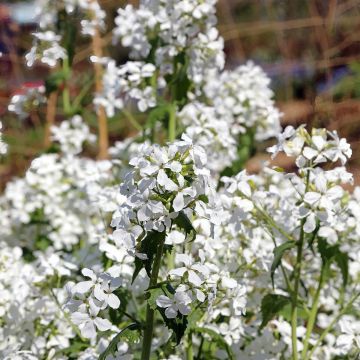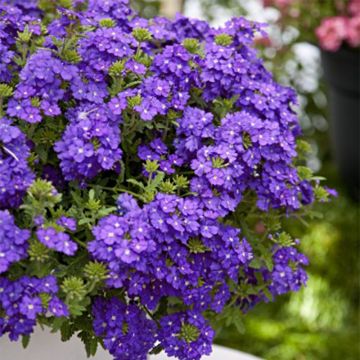

Anagallis Skylover - Mouron bleu de Monel Mini mottes


Anagallis Skylover - Mouron bleu de Monel Mini mottes
Anagallis monelli Skylover - Blue Pimpernel seeds
Anagallis monelli subsp linifolia Skylover
Blue Pimpernel, Garden Pimpernel, Monell's Pimpernel
Fantastic! Replace the lobelia in full sun. It has a beautiful continuous blue flowering. Light and very floriferous. The blue is intense. Easy plant in the sun and well watered. It should be used more in gardens.
Lantana, 27/08/2023
Special offer!
Receive a €20 voucher for any order over €90 (excluding delivery costs, credit notes, and plastic-free options)!
1- Add your favorite plants to your cart.
2- Once you have reached €90, confirm your order (you can even choose the delivery date!).
3- As soon as your order is shipped, you will receive an email containing your voucher code, valid for 3 months (90 days).
Your voucher is unique and can only be used once, for any order with a minimum value of €20, excluding delivery costs.
Can be combined with other current offers, non-divisible and non-refundable.
Home or relay delivery (depending on size and destination)
Schedule delivery date,
and select date in basket
This plant carries a 6 months recovery warranty
More information
We guarantee the quality of our plants for a full growing cycle, and will replace at our expense any plant that fails to recover under normal climatic and planting conditions.

Would this plant suit my garden?
Set up your Plantfit profile →
Description
The Monel blue pimpernel or Anagallis monelli Skylover is a delightful annual plant with incredibly intense gentian blue flowers that rivals the more well-known lobelias in popularity for use in flower beds and hanging baskets. With its attractive spreading and carpeting habit, and abundant flowering in summer, this variety is a stunning descendant of the wild pimpernel that roams through fallow land and along paths in the Western Mediterranean. Its flowers open in the morning and close in the afternoon, with narrow, rolled-edge, deep green leaves. This plant is highly decorative in rock gardens, borders, pots, and hanging baskets, where it will quickly spread. It thrives in heat, sun, well-drained soil, and can tolerate drought when planted in the ground.
The Anagallis monelli Skylover is a perennial plant but is frost-sensitive and short-lived, usually grown as an annual. It belongs to the primrose family. It is an improved variety of the Monel pimpernel, native to Morocco, southern Italy, and Portugal, where it is found in uncultivated areas and along paths. The plant forms carpeting clumps of 20-30 cm (8-12in) in all directions in just a few months, with woody stems at the base, ascending or prostrate, rooting at the nodes. They are covered with small leaves 1.5 cm (1in) long and 5 mm (0in) wide, lanceolate, with rolled edges, a fairly dark and shiny green, and covered with glandular hairs. Flowering occurs from June to September. The flowers have 5 cup-shaped petals, with an intense gentian blue colour contrasting with a small pinkish-violet center and a cluster of yellow stamens. They open in the morning and close in the mid-afternoon in hot weather.
The Skylover blue pimpernel is perfect in rock gardens, often paired with pussytoes, chickweeds, fragrant alyssums, or late spring-flowering bulbs (garlic, camassias, galtonias). In the front of borders, it pairs well with dwarf snapdragons, candytufts, California poppies, and linarias, among others. In hanging baskets or containers, the intense flower colour and shiny foliage complement the flowering of bacopas and scaevolas. It always makes a perfect match with lobelias and surfinias. You can also use it to decorate larger pots, at the base of taller perennials, which this wanderer will pleasantly invade.
Note: Please be aware that our young plug plants are professional products intended for experienced gardeners. Upon receipt, transplant them as soon as possible into pots, hanging baskets, or directly into flower beds.
Report an error about the product description
Anagallis monelli Skylover - Blue Pimpernel seeds in pictures






Flowering
Foliage
Plant habit
Botanical data
Anagallis
monelli subsp linifolia
Skylover
Primulaceae
Blue Pimpernel, Garden Pimpernel, Monell's Pimpernel
Anagallis collina , Lysimachia monelli
Cultivar or hybrid
Other Biennials A to Z
View all →Planting and care
The Monel anagallis grows in ordinary soil (even limestone), but it prefers well-drained, sandy, stony, or gravelly soil. It thrives in full sun and heat, but to limit its growth, it is best to avoid areas where the ambient temperature is too high. This plant shows more flowering and is more compact in the sun. When grown in pots, the soil should never completely dry out in summer, or else the flowering will stop. The young plants in plug plants should be cultivated for a few weeks in individual pots, protected from frost, to strengthen before being permanently placed in hanging baskets and flower beds or in the ground.
Planting period
Intended location
Care
-
, onOrder confirmed
Reply from on Promesse de fleurs
Similar products
Haven't found what you were looking for?
Hardiness is the lowest winter temperature a plant can endure without suffering serious damage or even dying. However, hardiness is affected by location (a sheltered area, such as a patio), protection (winter cover) and soil type (hardiness is improved by well-drained soil).

Photo Sharing Terms & Conditions
In order to encourage gardeners to interact and share their experiences, Promesse de fleurs offers various media enabling content to be uploaded onto its Site - in particular via the ‘Photo sharing’ module.
The User agrees to refrain from:
- Posting any content that is illegal, prejudicial, insulting, racist, inciteful to hatred, revisionist, contrary to public decency, that infringes on privacy or on the privacy rights of third parties, in particular the publicity rights of persons and goods, intellectual property rights, or the right to privacy.
- Submitting content on behalf of a third party;
- Impersonate the identity of a third party and/or publish any personal information about a third party;
In general, the User undertakes to refrain from any unethical behaviour.
All Content (in particular text, comments, files, images, photos, videos, creative works, etc.), which may be subject to property or intellectual property rights, image or other private rights, shall remain the property of the User, subject to the limited rights granted by the terms of the licence granted by Promesse de fleurs as stated below. Users are at liberty to publish or not to publish such Content on the Site, notably via the ‘Photo Sharing’ facility, and accept that this Content shall be made public and freely accessible, notably on the Internet.
Users further acknowledge, undertake to have ,and guarantee that they hold all necessary rights and permissions to publish such material on the Site, in particular with regard to the legislation in force pertaining to any privacy, property, intellectual property, image, or contractual rights, or rights of any other nature. By publishing such Content on the Site, Users acknowledge accepting full liability as publishers of the Content within the meaning of the law, and grant Promesse de fleurs, free of charge, an inclusive, worldwide licence for the said Content for the entire duration of its publication, including all reproduction, representation, up/downloading, displaying, performing, transmission, and storage rights.
Users also grant permission for their name to be linked to the Content and accept that this link may not always be made available.
By engaging in posting material, Users consent to their Content becoming automatically accessible on the Internet, in particular on other sites and/or blogs and/or web pages of the Promesse de fleurs site, including in particular social pages and the Promesse de fleurs catalogue.
Users may secure the removal of entrusted content free of charge by issuing a simple request via our contact form.
The flowering period indicated on our website applies to countries and regions located in USDA zone 8 (France, the United Kingdom, Ireland, the Netherlands, etc.)
It will vary according to where you live:
- In zones 9 to 10 (Italy, Spain, Greece, etc.), flowering will occur about 2 to 4 weeks earlier.
- In zones 6 to 7 (Germany, Poland, Slovenia, and lower mountainous regions), flowering will be delayed by 2 to 3 weeks.
- In zone 5 (Central Europe, Scandinavia), blooming will be delayed by 3 to 5 weeks.
In temperate climates, pruning of spring-flowering shrubs (forsythia, spireas, etc.) should be done just after flowering.
Pruning of summer-flowering shrubs (Indian Lilac, Perovskia, etc.) can be done in winter or spring.
In cold regions as well as with frost-sensitive plants, avoid pruning too early when severe frosts may still occur.
The planting period indicated on our website applies to countries and regions located in USDA zone 8 (France, United Kingdom, Ireland, Netherlands).
It will vary according to where you live:
- In Mediterranean zones (Marseille, Madrid, Milan, etc.), autumn and winter are the best planting periods.
- In continental zones (Strasbourg, Munich, Vienna, etc.), delay planting by 2 to 3 weeks in spring and bring it forward by 2 to 4 weeks in autumn.
- In mountainous regions (the Alps, Pyrenees, Carpathians, etc.), it is best to plant in late spring (May-June) or late summer (August-September).
The harvesting period indicated on our website applies to countries and regions in USDA zone 8 (France, England, Ireland, the Netherlands).
In colder areas (Scandinavia, Poland, Austria...) fruit and vegetable harvests are likely to be delayed by 3-4 weeks.
In warmer areas (Italy, Spain, Greece, etc.), harvesting will probably take place earlier, depending on weather conditions.
The sowing periods indicated on our website apply to countries and regions within USDA Zone 8 (France, UK, Ireland, Netherlands).
In colder areas (Scandinavia, Poland, Austria...), delay any outdoor sowing by 3-4 weeks, or sow under glass.
In warmer climes (Italy, Spain, Greece, etc.), bring outdoor sowing forward by a few weeks.















































